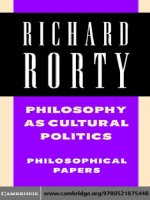cambridge university press media argumentation dialect persuasion and rhetoric sep 2007 kho tài liệu bách khoa
Bạn đang xem bản rút gọn của tài liệu. Xem và tải ngay bản đầy đủ của tài liệu tại đây (2.75 MB, 406 trang )
P1: RPU
9780521876902pre
CUNY979-Walton
978 0 521 87690 2
August 24, 2007
This page intentionally left blank
13:39
P1: RPU
9780521876902pre
CUNY979-Walton
978 0 521 87690 2
August 24, 2007
13:39
Media Argumentation
Dialectic, Persuasion, and Rhetoric
Media argumentation is a powerful force in our lives. From political speeches to television commercials to war propaganda, it can
effectively mobilize political action, influence the public, and market
products. This book presents a new and systematic way of thinking
about the influence of mass media in our lives, showing the intersection of media sources with argumentation theory, informal logic,
computational theory, and theories of persuasion. Using a variety of
case studies that represent arguments that typically occur in the mass
media, Douglas Walton demonstrates how tools recently developed
in argumentation theory can be usefully applied to the identification, analysis, and evaluation of media arguments. He draws on the
most recent developments in artificial intelligence, including dialogical theories of argument, which he developed, as well as speech act
theory. Walton provides a structural analysis not only of individual
types of argument commonly employed in the mass media, but also
of pragmatic frameworks (models of goal-directed conversation) in
which such arguments are used. Each chapter presents solutions to
problems central to understanding, analyzing, and criticizing media
argumentation.
Douglas Walton is professor of philosophy at the University of
Winnipeg. An internationally known scholar and author of more than
thirty books in the areas of argumentation, logic, and artificial intelligence, he has received major research grants from the Social Sciences
and Humanities Research Council of Canada and the Isaak Walton
Killiam Memorial Foundation. Dr. Walton also received the ISSA Prize
from the International Society for the Study of Argumentation for his
contributions to research on fallacies, argumentation, and informal
logic.
i
P1: RPU
9780521876902pre
CUNY979-Walton
978 0 521 87690 2
ii
August 24, 2007
13:39
P1: RPU
9780521876902pre
CUNY979-Walton
978 0 521 87690 2
August 24, 2007
Media Argumentation
Dialectic, Persuasion, and Rhetoric
DOUGLAS WALTON
University of Winnipeg
iii
13:39
CAMBRIDGE UNIVERSITY PRESS
Cambridge, New York, Melbourne, Madrid, Cape Town, Singapore, São Paulo
Cambridge University Press
The Edinburgh Building, Cambridge CB2 8RU, UK
Published in the United States of America by Cambridge University Press, New York
www.cambridge.org
Information on this title: www.cambridge.org/9780521876902
© Douglas Walton 2007
This publication is in copyright. Subject to statutory exception and to the provision of
relevant collective licensing agreements, no reproduction of any part may take place
without the written permission of Cambridge University Press.
First published in print format 2007
eBook (EBL)
ISBN-13 978-0-511-35469-4
ISBN-10 0-511-35469-X
eBook (EBL)
hardback
ISBN-13 978-0-521-87690-2
hardback
ISBN-10 0-521-87690-7
paperback
ISBN-13 978-0-521-70030-6
paperback
ISBN-10 0-521-70030-2
Cambridge University Press has no responsibility for the persistence or accuracy of urls
for external or third-party internet websites referred to in this publication, and does not
guarantee that any content on such websites is, or will remain, accurate or appropriate.
P1: RPU
9780521876902pre
CUNY979-Walton
978 0 521 87690 2
For Karen, with love
v
August 24, 2007
13:39
P1: RPU
9780521876902pre
CUNY979-Walton
978 0 521 87690 2
vi
August 24, 2007
13:39
P1: RPU
9780521876902pre
CUNY979-Walton
978 0 521 87690 2
August 24, 2007
13:39
Contents
Acknowledgments
1
2
Introduction
Logic, Dialectic, and Rhetoric
1. The Viewpoint of Informal Logic
2. The Old Dialectic of the Greeks
3. The Opposition between Rhetoric and Dialectic
4. Topics and Fallacies
5. Persuasion, Social Influence, and Democracy
6. Argumentation Schemes
7. Basic Practical Reasoning
8. Value-Based Practical Reasoning
9. The Star Trek Example
10. The Aims of Dialectical and Rhetorical Argumentation
The Speech Act of Persuasion
1. The Belief-Desire-Intention Approach and the Commitment
Approach
2. Basic Components of Persuasion
3. Chaining of Argumentation
4. Types of Dialogue
5. Deliberation
6. Closing of the Deliberation Dialogue
7. Acts of Persuasion, Inducement, and Making a Threat
8. Negotiation Dialogue and Persuasion
9. Relevance and Argument Diagramming
10. The Cognitive Component of Persuasion
11. The New Definition of the Speech Act of Persuasion
page xi
1
7
8
11
15
19
23
26
30
34
37
41
46
47
53
56
60
64
66
69
73
79
84
87
vii
P1: RPU
9780521876902pre
CUNY979-Walton
978 0 521 87690 2
August 24, 2007
Contents
viii
3
4
5
6
13:39
Propaganda
1. Negative Connotations
2. Public Discourse and Reason
3. Appeal to the People Revisited
4. The Dialectical Viewpoint on Propaganda
5. Persuasion and Propaganda
6. Characteristics of Propaganda
7. Is Propaganda Necessarily Dishonest or Irrational?
8. Openness to Contrary Evidence
9. Deceptiveness and Relevance in Propaganda
10. Evaluating Argumentation in Propaganda
Appeals to Fear and Pity
1. Appeals to Fear and Pity in Mass Media
2. Appeals to Fear
3. Appeals to Pity
4. The Respondent-to-Dialogue Problem
5. Simulative Reasoning
6. The Dual Process Model of Persuasion
7. The Structure of Appeals to Fear
8. The Structure of Appeals to Pity
9. Multi-agent Structure of Both Types of Argument
10. When Are Appeals to Fear and Pity Fallacious?
Ad Hominem Arguments in Political Discourse
1. Classifying the Types of Ad Hominem Argument
2. The Circumstantial and Other Types
3. Argument from Commitment
4. The Gore Case
5. The Battalino Case
6. Classifying the Argument in the Battalino Case
7. Evaluating the Argument in the Battalino Case
8. Implicature and Innuendo
9. Evaluating the Argument in the Gore Case
10. Evaluating the Arguments Rhetorically and Dialectically
Arguments Based on Popular Opinion
1. Influencing the Mass Audience
2. Appeal to Popular Opinion as an Argument
3. Cases in Point
4. The Form of the Argument
5. Fallacious Appeals to Popular Opinion
6. Endoxa in Greek Dialectic
7. Public Opinion as Informed Deliberation
8. A More Careful Basis for Evaluating Cases
91
92
96
99
104
106
109
114
117
120
122
127
128
131
134
138
142
145
147
150
153
156
161
163
165
169
173
177
180
183
185
190
192
198
199
202
204
207
211
213
215
218
P1: RPU
9780521876902pre
CUNY979-Walton
978 0 521 87690 2
August 24, 2007
Contents
9. Viewing the Public as an Agent
10. Evaluating Appeal to Popular Opinion
7
8
9
Fallacies and Bias in Public Opinion Polling
1. Definitions and Sampling Surveys
2. Question Wording and Emotive Bias in Polls
3. The Structure of the Question
4. Forcing an Answer
5. Use of Polls by Advocacy Groups
6. The Advent of Deliberative Polling
7. Argumentation Schemes and Critical Questions
8. Using Formal Dialectical Models of Argumentation
9. Combining Dialectical and Empirical Methods
10. Conclusion and Summary of Fallacies
Persuasive Definitions and Public Policy Arguments
1. Stevenson’s Theory of Persuasive Definitions
2. Cases of Public Redefinitions
3. Wider Implications of These Cases
4. Definitions in the New Dialectic
5. Proof of Legitimacy of Persuasive Definitions
6. Argumentation Schemes Relating to Definitions
7. The Speech Act of Defining
8. Evaluating Persuasive Definitions
9. What Should the Rules for Persuasive Definitions Be?
10. Conclusions
The Structure of Media Argumentation
1. Rhetoric and Dialectic Reconfigured
2. The Respondent-to-Dialogue Problem Revisited
3. Direct and Indirect Media Argumentation
4. Star Trek: The Rhetorical Dimension
5. Argumentation Strategies
6. Plan Recognition
7. The Solution to the RTD Problem
8. Fifteen Basic Components of Media Argumentation
9. The Persuasion System
10. Computational Dialectics for Rhetorical Invention
13:39
ix
222
224
228
229
235
239
244
249
254
259
263
267
270
275
276
281
288
292
297
300
308
310
316
319
323
324
327
330
334
338
342
347
350
353
355
Bibliography
361
Index
373
Color plate section follows page 34.
P1: RPU
9780521876902pre
CUNY979-Walton
978 0 521 87690 2
x
August 24, 2007
13:39
P1: RPU
9780521876902pre
CUNY979-Walton
978 0 521 87690 2
August 24, 2007
13:39
Acknowledgments
Some of the material in this book is based on material in journal articles
previously published by the author. The previously published materials
have been modified to fit as revised material in parts of chapters.
Chapter 3 is based on “What Is Propaganda and Exactly What Is Wrong
with It?” Public Affairs Quarterly 11 (1997): 383–413. The work in chapter 3 was supported by a Fellowship from the Netherlands Institute for
Advanced Study in the Humanities and Social Sciences (NIAS) and a
Research Grant from the Social Sciences and Humanities Research Council of Canada during the academic year of 1990–1991. Thanks are due to
Erik Krabbe for discussions and to the members of the NIAS Research
Group on “Fallacies as Violations of Rules of Argumentative Discourse,”
Frans van Eemeren, Rob Grootendorst, Sally Jackson, Scott Jacobs, Agnes
van Rees, Agnes Verbiest, Charles Willard, and John Woods.
Material from two previously published papers is included in chapter
5: “Use of Ad Hominem Argument in Political Discourse: The Battalino
Case from the Impeachment Trial of President Clinton,” Argumentation
and Advocacy 36 (2000): 179–195, and “Case Study of the Use of Circumstantial Ad Hominem in Political Argumentation,” Philosophy and Rhetoric
33 (2000): 101–115. The former paper was written while I was on study
leave in Perth, Australia, and Eugene, Oregon, in 1997. I would like
to thank the Department of Philosophy of the University of Western
Australia for providing facilities for research, and the Oregon Humanities Center (University of Oregon) for supporting my research on this
paper. I would also like to acknowledge some comments made by Henry
W. Johnstone, Jr. The latter paper arose out of the graduate seminar on argumentation I gave as a visiting professor at Northwestern
xi
P1: RPU
9780521876902pre
xii
CUNY979-Walton
978 0 521 87690 2
August 24, 2007
13:39
Acknowledgments
University in the Department of Communication Studies in 1999 and
a public lecture given at Northwestern in April 1999. My visit was
also supported by a Fulbright Senior Research Fellowship. Among the
many individuals who contributed to the paper by raising questions and
making comments, I would especially like to thank Mike Leff, Jean Goodwin, Steve Wildman, David Zarefsky, Robert McKown, Lynn Clarke, Adrienne Brovero, Michael Geiser, Horoko Okuda, Susan Sattell, and Michael
Pfau. For support of the research in this paper, I would like to thank the
Canada-U.S. Fulbright Foundation, the Department of Communication
Studies of Northwestern University, and the Social Sciences and Humanities Research Council of Canada. During a later phase of the work in
2004, discussions with Mark Aakhus and David Zarefsky turned out to be
extremely helpful.
Chapter 6 is partly based on “Evaluating Appeals to Popular Opinion,”
Inquiry: Critical Thinking Across the Disciplines 20 (2000): 33–45. The material in the paper has been considerably revised, and much new material
has been added.
Chapter 8 is based on “Persuasive Definitions and Public Policy Arguments,” Argumentation and Advocacy: The Journal of the American Forensic
Association 37 (2001): 117–132. Much of the paper has been revised, and
considerable new material has been added.
I gained some valuable insights into argumentation and computing
at the Symposium on Argument and Computation at Bonskeid House
in Perthshire, Scotland, in June and July 2000. I would especially like
to thank Tim Norman and Chris Reed for organizing the conference.
I would also like to thank the following conference participants for
lectures and discussions that have influenced my thinking on models
of argumentation and deliberation: Trevor Bench-Capon, Daniela Carbogim, Jim Crosswhite, Aspassia Daskalopulu, John Fox, Jim Freeman,
Janne Maaike Gerlofs, Michael Gilbert, Rod Girle, Floriana Grasso, Leo
Groarke, Corin Gurr, David Hitchcock, Hanns Hohmann, Erik Krabbe,
Peter McBurney, Henry Prakken, Theodore Scaltsas, Simone Stumpf,
and Bart Verheij. In the second term of 2001, during my time as visiting professor in the Department of Communication at the University of
Arizona, I began to appreciate how the study of some phenomena central
in rhetorical persuasion could benefit from new tools developed in computing and argumentation. For helpful discussions during this period,
I would like to thank Joe Bonito, Michael Dues, Hans Hansen, Scott
Jacobs, Sally Jackson, Raymie McKerrow, Robin Nabi, Chris Segrin, Kyle
Tusing, David Williams, and Ron Wright. Support during this period was
P1: RPU
9780521876902pre
CUNY979-Walton
Acknowledgments
978 0 521 87690 2
August 24, 2007
13:39
xiii
provided by a half-year study leave granted by the University of Winnipeg
and a research grant from the Social Sciences and Humanities Research
Council of Canada.
Finally I would like to thank Tom Gordon, Henry Prakken, Chris Reed,
and Bart Verheij for many discussions over the period of 2002–2006 that
helped to sharpen my grasp of new developments in artificial intelligence that are turning out to be essential to recent advances in argumentation technology. I would like to thank Christian Kock for allowing
me to preview his paper for the 2006 ISSA Conference. And I would
like to acknowledge the support for my continuing research through my
Research Grant on Dialogue Systems for Legal Argumentation given by
the Social Sciences and Humanities Research Council of Canada in 2005.
For help during this latter period leading up the publication of the book,
I would like to thank David Godden and Fabrizio Macagno. Rita Campbell
prepared the index, and Ruth Lowe helped with proofreading.
P1: RPU
9780521876902pre
CUNY979-Walton
978 0 521 87690 2
xiv
August 24, 2007
13:39
P1: RPU
9780521876902int
CUNY979-Walton
978 0 521 87690 2
August 24, 2007
13:41
Introduction
What initially led me to start work on this project was the observation
that the examples of fallacies and questionable argument tactics studied
in textbooks of informal logic often featured examples of advertisements
and political arguments of the kind that have to do with elections or
with public policies. Many of them are media arguments from sources
such as political speeches, commercial ads, or Internet blogs. Such arguments are especially interesting when it is evident that they were used –
for example, in ads – as rhetorically effective techniques to persuade a
mass audience. Formerly (and often still), such arguments tended to be
classified in logic as fallacious. But more and more they are now seen
as fallible (but slippery) heuristics useful to reach a tentative conclusion
under conditions of uncertainty, but subject to critical questioning. The
theory put forward in this book strikes a judicious balance between analyzing them as fallible but basically reasonable arguments in some cases,
and criticizing them as fallacious arguments used as tactics to unfairly get
the best of an opponent or deceive a mass audience in other cases.
More specifically, the kinds of arguments considered throughout the
book are ones often used in various communication media, including
written texts, television, and the Internet, to attempt to persuade an
audience to do something or accept something as true. A broad variety
of such arguments are analyzed, but they prominently include political
arguments and appeals, especially as used in electoral campaigns, encompassing persuasion attempts in which politicians, corporations, or advocacy groups put forward arguments using mass media and the Internet.
They also include staged public debates in legislatures and parliaments
and arguments found in commercial ads, in news reports or editorials
1
P1: RPU
9780521876902int
2
CUNY979-Walton
978 0 521 87690 2
August 24, 2007
13:41
Media Argumentation
in newspapers and magazines, and in written transcripts of television
broadcasts and other media programs. They include any specimens of
argumentation that have appeared in the various mass media and can be
taken to try to influence a mass audience in some way. The aim of such
an argument is typically to get action or to change public opinion on an
issue, although other goals can be involved as well. The problem is to
unlock the mystery of how persuasion works in such arguments using a
dialogue model.
Despite a large body of experimental work in the social sciences that
has studied the persuasive effectiveness of messages, for example, we
still have very little precise understanding of exactly what persuasion is
and how it works in mass media. As O’Keefe (2001, p. 575) put it, “Persuasion has been one of the great continuing mysteries of rhetoric and
related disciplines.” This book dissipates some of the mystery by building on recent work in argumentation theory and multi-agent systems in
artificial intelligence (AI). These fields have developed new tools that
have been applied to argumentation, leading to the development of new
argumentation technologies, but one of the problems has been to extend
them to argumentation of a kind that has traditionally been studied in
rhetoric and speech communication.
The contemporary field of argumentation derives from three different disciplinary roots: logic, dialectic, and rhetoric. Logic is the science
of reasoning. Dialectic is the study of two parties reasoning together with
each other by argument and objection. Rhetoric is the use of argument
to persuade.1 Each has been somewhat suspicious of the claims advanced
by the others, reflecting a tension going back to the ancient origins of
all three fields. Rhetoric especially has been suspect, seen by philosophers as a sham and a deception, trading on the biases of audiences and
not advancing claims that demand to be taken seriously. Philosophy has
long been at war with rhetoric, since the time of Plato. Plato said that
rhetoric is used by Sophists, is based only on appearances, and is used to
persuade audiences by arguments that are fallacious. According to Plato,
the Sophist has no regard for the truth of the matter, and can make the
worse argument look better, or the better argument look worse, by tricky
arguments. Philosophy, in contrast, on the Platonic theory, can take us to
the fixed and unchanging truth of a matter being discussed by means of
a method he called dialectic. Rhetoric produces only belief, which is
1
These are superficial initial definitions for the beginner, subject to considerable refinement as the book proceeds. They are controversial and very much at issue.
P1: RPU
9780521876902int
CUNY979-Walton
Introduction
978 0 521 87690 2
August 24, 2007
13:41
3
constantly changing, while philosophy yields knowledge. The word
“dialectic” (in this special sense) derives from the ancient Greek term
for conversation, dialectikos, evoking the Platonic dialogues. Both Plato
and Aristotle saw dialectic as a highly important method of rational discussion.2 Plato couldn’t really make up his mind what dialectic was, but
by showing his paradigm exponent of it, Socrates, practicing it in his dialogues, gave examples of it at work. Later, Aristotle tried to redress Plato’s
antagonistic view of the relationship between rhetoric and dialectic by
inventing formal logic, trying to reconcile rhetoric with a field he called
dialectic. He defined dialectic as a way of criticizing popularly accepted
opinions by finding contradictions and logical weaknesses in them and
by considering arguments on both sides of a contested issue. But dialectic
died out after some attempts to revive it in the Middle Ages.3 The outcome, which has persisted for over two millennia, is that philosophy and
rhetoric are still at war.
Recent developments demand a new look into this conflict. Because
of the need to devise systems for electronic communication on the Internet, computing is moving more and more to a model of argumentation
as a dialogue between rational agents. Current technologies of artificial
intelligence are now widely based on the possibility of communications
among entities that can act, reason, ask questions, and exchange information. For example, you might have an agent that filters out your E-mail
messages, deletes some, and marks others with a high priority. Or you
might have an agent that searches around the Net, collects certain kinds
of information, and then processes it in a format you can use for some
purpose. To collect this information, the agent will have to ask questions of other agents. Goal-directed communication between agents, or
among groups of agents engaged in projects that require teamwork, is
more and more important for many applications in electronic commerce
and information retrieval. These developments provide an argumentation technology that offers new insight into mass media argumentation
through an interlocking of dialectic and rhetoric.
In this book it is argued that rhetorical and dialectical argumentation
need to be fitted together as complementary fields integrating two main
tasks, the invention of arguments and their critical evaluation. The main
2
3
But the term, in its Greek meaning, is likely to be unfamiliar to the majority of presentday readers, who are most likely to associate it with (quite different) Marxist-Hegelian
notions.
In modern times, Marxist-Hegelian theorists took over the term, signaling its death.
P1: RPU
9780521876902int
4
CUNY979-Walton
978 0 521 87690 2
August 24, 2007
13:41
Media Argumentation
rhetorical task is to devise new arguments that can be used to persuade
an audience to come to accept a viewpoint it has doubts about, based on
what are taken to be its commitments and values. The main dialectical
task is to judge which arguments are stronger and which are weaker (or
even fallacious) by appealing to structures based on forms of argument
and procedural rules that specify conditions for appropriate uses of an
argument. It is argued in this book that even though these two goals are
inherently different in theory, in practice they are closely connected. The
reason is that audiences generally tend to be persuaded by arguments that
are fallible (defeasible, to use the current term), and can sometimes be
highly deceptive and even fallacious, but if used rightly, are inherently
reasonable. Such defeasible arguments are very common, for example,
in politics, where situations are highly complex, and a decision has to be
made under conditions of uncertainty and lack of knowledge. In showing us how to use and judge such arguments, rhetoric and dialectic can
combine to be a powerful force in the new argumentation technology
that is emerging, especially in a democracy.
Whereas rhetorical and dialectical arguments are usually seen as very
different, this book shows how they are both built on the same underlying
structures of argumentation. Both are built on argumentation schemes,
or stereotypical forms of argument. Both are built on the cognitive structure of the speech act of rational persuasion, requiring a dialogue format
in which a message sender (called the “proponent” in this book) uses
an argument to try to overcome the doubt expressed by another agent
(called the “respondent”) she is communicating with. To do this successfully, the proponent has to understand “where the respondent is coming
from.” She has to make some estimate of what premises he accepts or can
be persuaded to accept as the dialogue proceeds.
The book shows that the tool of simulative reasoning is the means
needed for this purpose, in both dialectic and rhetoric. It explains what
arguers do in rhetorical situations: they imagine a dialogue to establish
the initial position of the audience, and they then work within that framework to persuade the audience through dialectically secured claims. This
works just like a dialogue except that the audience can’t respond to the
arguer’s questions, so he or she must anticipate and account for what the
audience would say. However, modifying the notion of dialogue so that
it can accommodate simulative reasoning of this sort requires a complex
and careful process of adaptation. The treatment of arguments based on
definitions or on a variety of other different kinds of evidence – studied
in the middle chapters of the book – identifies some of the ways in which
P1: RPU
9780521876902int
CUNY979-Walton
Introduction
978 0 521 87690 2
August 24, 2007
13:41
5
this is done. The book shows how simulative reasoning can be captured
in a dialogue model of argumentation that integrates reasoning used
in dialectical and rhetorical argumentation, explaining how each component is needed to understand what is really going on in mass media
argumentation.
The dialogue model has recently been adopted in multi-agent computing, and one can see why, because automated agents are used in communication on the Internet for purposes such as electronic commerce. The
way argumentation is presented on the Internet fits the dialogue format
in a way that is evident to all of us as users. The dissemination of news and
information is becoming less centralized, and with this fragmentation we
are continually returning to a “conversational” model of communication
and information exchange. For example, it is not just that news networks
such as CNN report the results of daily, Internet-based, opinion polls
from their viewers. They now include blogs as a regular segment of their
newscasts in recognition that an increasing portion of the population is
seeking their information from this type of source. Yet the medium of a
blog is inherently interactive. It is a kind of “online diary,” usually of a
single individual, which allows comments and feedback from the readers
of the blog. Just as readers can immediately engage with the material on
the blog as they read it, the author of the blog, through her continued
updates, is able to respond to her interlocutors as individuals. The central task undertaken in this book is to apply this conversational model to
media argumentation by integrating rhetorical and dialectical factors in
the model.
Media argumentation is a powerful force in our lives. From political
speeches to TV commercials to war propaganda, it can appeal to emotions
that mobilize political action, influence public opinion, market products,
and even enable a dictator to stay in power. If we could study this kind of
argumentation using precise models of a kind that are clear enough to
build into implemented computing systems, we might be in a much better
position to deal with it in an intelligent and balanced way. But there are
certain central mechanisms of media argumentation that are still not well
enough understood. This book presents a new theory that displays its key
structural components and shows how they fit together. The evidence in
the case studies and analyses lead to the formulation of a new system to
model the structure of rhetorical argumentation, which I call the Persuasion System. This system, along with the other tools and structural
components deployed and refined through the case studies, reveal that
media arguments have precisely definable characteristics of their own
P1: RPU
9780521876902int
6
CUNY979-Walton
978 0 521 87690 2
August 24, 2007
13:41
Media Argumentation
that make them a distinctive use of argumentation with a dialectical structure and rhetorical trajectory fitted together in a dialogue framework. By
seeing how they work in typical and in problematic cases of mass media
persuasion, fresh light is thrown on important and influential techniques
of argumentation in the communication media. Each chapter presents
solutions to problems central to understanding, analyzing, and criticizing
media argumentation.
P1: RPU
9780521876902c01
CUNY979-Walton
978 0 521 87690 2
August 24, 2007
11:13
1
Logic, Dialectic, and Rhetoric
The three fields of logic, rhetoric, and dialectic are all about arguments, as
Aristotle showed, but each takes a different viewpoint on them.1 Logic is
the science of reasoning that studies formal inferential links between sets
of propositions designated as premises and conclusion of an argument.
Dialectic, usually taken to be a branch of logic, analyzes arguments given
in a text of discourse, including fallacious arguments, evaluating them
as weak or strong by examining criticisms of them (Kapp 1942; Walton
1998b; Finocchiaro 2005, ch. 13). Rhetoric studies persuasive arguments
based on the beliefs, commitments, or values of the target audience to
be persuaded (Kennedy 1963; Tindale 1999, 2004; Jacobs 2000). However, the long history of the relationship between logic and rhetoric has
been an antagonistic one, characterized by strife and sniping on both
sides, beginning with Plato’s attack on the Sophists on the basis that
they took fees to teach argumentation skills.2 This attack on rhetoric
is visible in many places in Plato’s dialogues (Krabbe 2000, p. 206).3
Aristotle took a balanced view of what he saw as a close relationship
between rhetoric and dialectic, but an opposition between the two subjects remained (Hohmann 2000, p. 223). Aristotle thought of dialectic
1
2
3
The first sentence of the Rhetoric (1354a1) is: “Rhetoric is the counterpart of dialectic.”
Aristotle saw both arts as about persuasion (Rhetoric, 1354a13–1354a14). See Kennedy
1991, 1994).
The ancient history of dialectic as a branch of logic is well described by Kapp (1942),
while that of rhetoric as a subject designed for persuasion is equally well described by
Kennedy (1963).
In the Georgias (463a–463d), Socrates denounced rhetoric as nothing more than “flattery”
(kolakeia).
7
P1: RPU
9780521876902c01
CUNY979-Walton
978 0 521 87690 2
August 24, 2007
11:13
Logic, Dialectic, and Rhetoric
8
as “a rather pure and theoretically sound method aimed at a cooperative search for cognitive truth” (Hohmann 2000, p. 223),4 and hence by
comparison, rhetoric still had negative implications that are still present.
The aim of rhetorical argumentation seems to make it subjective,
because it needs to persuade by picking premises that represent the values of the specific audience (Johnstone 1981; Tindale 2004), values that
can vary from one group to another. To do this successfully, the proponent has to understand “where the audience is coming from.” Using a
fictional example from Star Trek, featuring Klingons, Ferengi, and Vulcans, this chapter shows how dialectic also needs to base arguments on
premises that represent the values of the specific audience or respondent to whom the argument is addressed. Another goal of this chapter
is to introduce the reader to some new tools of argumentation theory,
such as argument diagramming and argumentation schemes, forms of
argument representing stereotypical types of reasoning used in everyday
conversational interactions. Thus this chapter will show how dialectical
argumentation, especially as it is being refashioned by recent developments of argumentation technology in AI, has become a much better
developed branch of logic, which has moved more into a rapprochement with rhetoric. This chapter will take the first steps toward achieving
the ultimate goal of displaying the key structural components of rhetorical argumentation, and will show how they fit together with logical and
dialectical approaches to argumentation. What used to be called dialectic, and is coming to be so called again, has often been called informal
logic in recent years. Informal logic has a special viewpoint, setting it
apart from the much better developed field of formal logic.
1. The Viewpoint of Informal Logic
When it comes to studying arguments, there are two points of view, or ways
of analyzing and evaluating an argument, that need to be distinguished.
First, you can study the argument empirically to try to judge what effect
it had, or will be likely to have, on an audience. This viewpoint would
seem to be one that would fit the kind of approach and methods of the
social sciences. The other point of view is logical. You can classify the
4
Aristotle portrayed rhetoric as “a seriously tainted and practically compromised knack
serving a competitive quest for persuasive success” by contrasting it with the purely intellectual subject of dialectic (Hohmann 2000, p. 223), which studies reasoning supporting
or criticizing an argument.
P1: RPU
9780521876902c01
CUNY979-Walton
978 0 521 87690 2
The Viewpoint of Informal Logic
August 24, 2007
11:13
9
argument as being of a particular type. By means of such a classification,
you show the given argument to be an instance of some abstract form
of argument. Then you can analyze it by finding missing assumptions it
is based on. Then you can determine whether the argument is correct
or incorrect (valid or invalid, reasonable or fallacious). In other words,
you can evaluate it according to the normative standards of correctness
that this type of argument is supposed to meet. It has been thought,
since the end of the nineteenth century, that these two tasks were entirely
independent from each other and that they should be carefully separated
and never mixed in together. But recently, the feeling has been that this
separation is not as clean as was once thought (Johnson 2000).
The following thumbnail sketch of the history of logic will amplify this
point. Aristotle’s syllogistic, along with the Stoic logic of propositions,
developed into the science of deductive logic, which, in the twentieth
century, became mathematical logic. On the other hand, Aristotle’s practical logic – which comprised the study of “sophistical refutations” or
fallacies, which comes under the heading of “dialectical reasoning,” in
which two parties reason with each other – fell into obscurity and neglect.
Something approximating a resurrection of it was attempted in the nineteenth century, most notably, when idealist philosophers wrote about
so-called laws of thought. With the ascendancy of formal (mathematical)
logic, however, the whole idealist vision of laws of thought was repudiated, and called psychologism – a pejorative term, as then used in
logic. A sharp separation was made between how people actually think
(psychologically) and how they ought to think (logically) if they are to be
rational.
Now to return from this thumbnail sketch, it can be seen why in logic
there is thought to be a sharp separation between the empirical and normative viewpoints. Recent developments, however, have started to indicate that this separation is not as clean or sharp as it was thought to be.
One recent development is the return to the quest, originating in Aristotle’s older logic of the Topics and On Sophistical Refutations, of studying
informal fallacies. It has been found that to study the fallacies with any
hope of success, attention must be paid to realistic cases in which arguments are used for various conversational purposes in different contexts.
Such an approach requires getting beyond simplistic one-liner examples
of fallacies and looking at individual cases in some detail on their merits. Needless to say, such a pragmatic case-oriented approach to realistic
argumentation introduces something of an empirical component. While
the abstract form of the argument (the so-called argumentation scheme)









